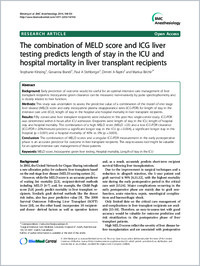The combination of MELD score and ICG liver testing predicts length of stay in the ICU and hospital mortality in liver transplant recipients.
- Klinzing S Surgical Intensive Care Medicine, University Hospital of Zurich, Raemistrasse 100, CH-8091 Zurich, Switzerland.
- Brandi G Surgical Intensive Care Medicine, University Hospital of Zurich, Raemistrasse 100, CH-8091 Zurich, Switzerland.
- Stehberger PA Surgical Intensive Care Medicine, University Hospital of Zurich, Raemistrasse 100, CH-8091 Zurich, Switzerland.
- Raptis DA Department of Visceral- and Transplantation Surgery, University Hospital of Zurich, Zurich, Switzerland.
- Béchir M Surgical Intensive Care Medicine, University Hospital of Zurich, Raemistrasse 100, CH-8091 Zurich, Switzerland.
- 2015-04-07
Published in:
- BMC anesthesiology. - 2014
Hospital mortality
Indocyanine green liver testing
Length of stay in the ICU
MELD score
Adolescent
Adult
Aged
Aged, 80 and over
Cohort Studies
End Stage Liver Disease
Female
Hospital Mortality
Humans
Indocyanine Green
Length of Stay
Liver Function Tests
Liver Transplantation
Male
Middle Aged
Postoperative Complications
Predictive Value of Tests
Transplant Recipients
Young Adult
English
BACKGROUND
Early prediction of outcome would be useful for an optimal intensive care management of liver transplant recipients. Indocyanine green clearance can be measured non-invasively by pulse spectrophometry and is closely related to liver function.
METHODS
This study was undertaken to assess the predictive value of a combination of the model of end stage liver disease (MELD) score and early indocyanine plasma disappearance rates (ICG-PDR) for length of stay in the intensive care unit (ICU), length of stay in the hospital and hospital mortality in liver transplant recipients.
RESULTS
Fifty consecutive liver transplant recipients were included in this post Hoc single-center study. ICG-PDR was determined within 6 hours after ICU admission. Endpoints were length of stay in the ICU, length of hospital stay and hospital mortality. The combination of a high MELD score (MELD >25) and a low ICG-PDR clearance (ICG-PDR < 20%/minute) predicts a significant longer stay in the ICU (p = 0.004), a significant longer stay in the hospital (p < 0.001) and a hospital mortality of 40% vs. 0% (p = 0.003).
CONCLUSION
The combination of MELD scores and a singular ICG-PDR measurement in the early postoperative phase is an accurate predictor for outcome in liver transplant recipients. This easy-to-assess tool might be valuable for an optimal intensive care management of those patients.
Early prediction of outcome would be useful for an optimal intensive care management of liver transplant recipients. Indocyanine green clearance can be measured non-invasively by pulse spectrophometry and is closely related to liver function.
METHODS
This study was undertaken to assess the predictive value of a combination of the model of end stage liver disease (MELD) score and early indocyanine plasma disappearance rates (ICG-PDR) for length of stay in the intensive care unit (ICU), length of stay in the hospital and hospital mortality in liver transplant recipients.
RESULTS
Fifty consecutive liver transplant recipients were included in this post Hoc single-center study. ICG-PDR was determined within 6 hours after ICU admission. Endpoints were length of stay in the ICU, length of hospital stay and hospital mortality. The combination of a high MELD score (MELD >25) and a low ICG-PDR clearance (ICG-PDR < 20%/minute) predicts a significant longer stay in the ICU (p = 0.004), a significant longer stay in the hospital (p < 0.001) and a hospital mortality of 40% vs. 0% (p = 0.003).
CONCLUSION
The combination of MELD scores and a singular ICG-PDR measurement in the early postoperative phase is an accurate predictor for outcome in liver transplant recipients. This easy-to-assess tool might be valuable for an optimal intensive care management of those patients.
- Language
-
- English
- Open access status
- gold
- Identifiers
-
- DOI 10.1186/1471-2253-14-103
- PMID 25844060
- Persistent URL
- https://sonar.ch/global/documents/298375
Statistics
Document views: 24
File downloads:
- fulltext.pdf: 0
